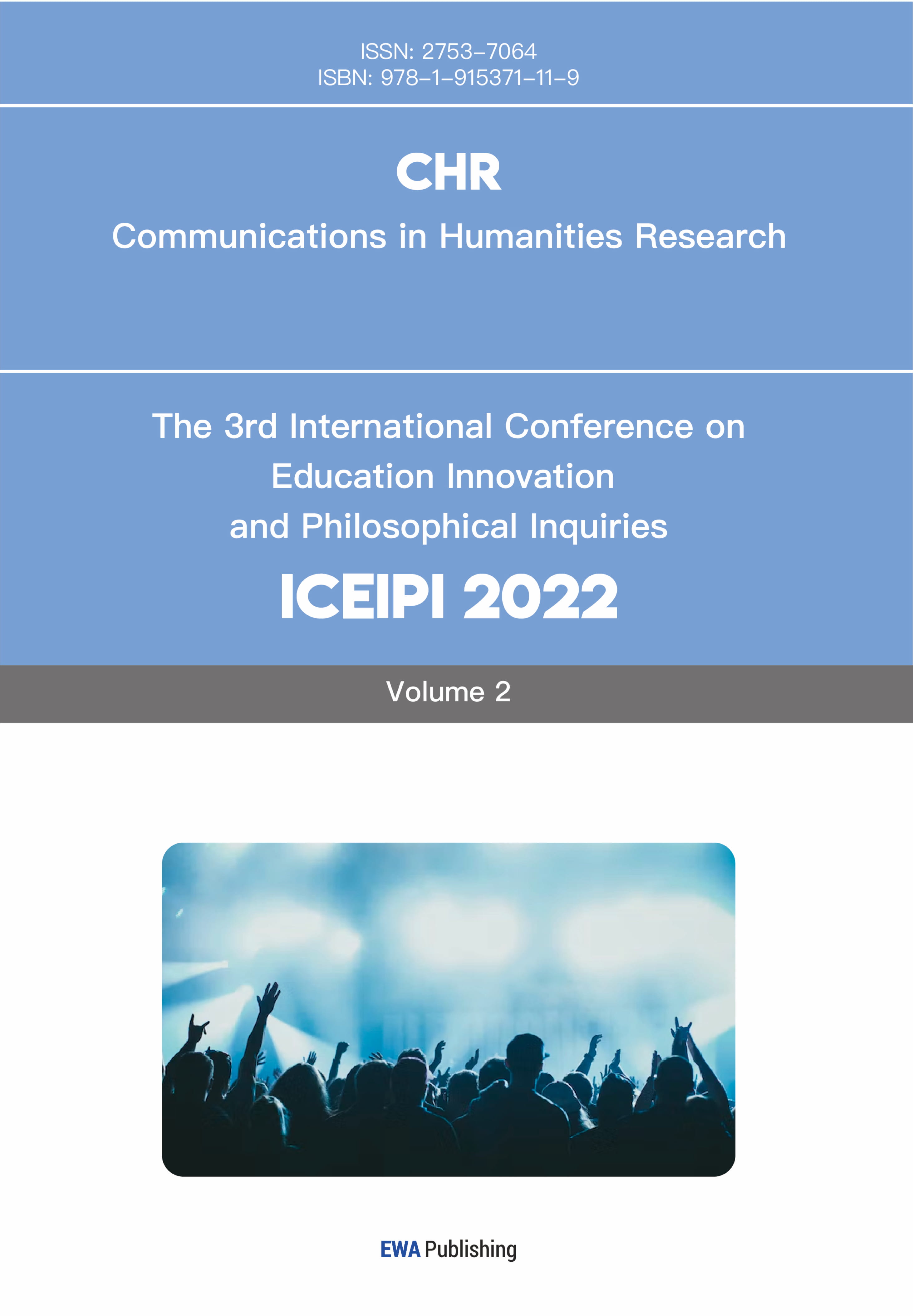References
[1]. He, B.B. (2022) Female Images in James Joyce's The Dead. Literature Education, (7), 83-85.
[2]. Hu, Q.R. (2019) A new reading of the narrative gaps in Joyce’s Eveline. Foreign Literature Studies, 41(4), 64-74.
[3]. Norris, M. (2003) Suspicious readings of Joyce's Dubliners. Philadelphia, PA: University of Pennsylvania Press.’s
[4]. Wang, J.J. (2016) On Joyce's short story Eveline. Literature Education, (9), 22-23.
[5]. Cai, Y.T. (2020) On the female images in Joyce's novel collection Dubliners: A case study of Eveline. Prose Hundred, (8), 38.
[6]. Tan, X.J. (2012) Should Eveline choose to elope? - Analysis of female consciousness in Eveline. Journal of Mudanjiang College of Education, (3), 14-15.
[7]. Wei, H. (2015) The social context and historical metaphor of Eveline. Jinan Journal (Philosophy & Social Sciences), 37(6), 140-148.
[8]. Wang, T.R., and Zhang, Z.J. (2022) The dilemma of female consciousness in Eveline from the perspective of narratology. Literature Education, (5), 68-72.
[9]. Jung, C.G., Hull, R.F.C., and Baynes, H.G. (2014) The type problem in psychopathology. In C.G. Jung (Ed.), Psychological types (pp. 273-288). Princeton, NJ: Princeton University Press.
[10]. Bettin, C., and Mills, A.J. (2018) More than a feminist: ANTi-Historical reflections on Simone de Beauvoir. Management & Organizational History, 13(1), 65-85.
[11]. Ashraf, K., and Hassan, M. (2021) Identifying Beauvoir’s idea of equal freedom in Munir’s unfettered wings; Extraordinary stories of ordinary women: An existential feminist approach. Journal of Languages, Culture and Civilization, 3(3), 157-168.
[12]. Mahon, J. (1997) Existentialism, feminism and Simone de Beauvoir. New York, NY: Springer.
[13]. Chen, X.L. (2007) Beauvoir's Second Sex Chinese reading——1980-2007. (Master's thesis), Shanghai University, Shanghai.
[14]. Zhao, Y.Q. (2021) Contemporary significance of Beauvoir's existentialist feminist theory. (Master's thesis), Liaoning University, Shenyang.
[15]. Joyce, J. (2008) Dubliners. Oxford: Oxford University Press.
[16]. Kenner, H. (1972) Molly's Masterstroke. James Joyce Quarterly, 10(1), 19-28.
[17]. Mullin, K. (2000) Don’t cry for me Argentina:‘Eveline’and the seductions of emigration propaganda. In D. Attridge, M. Howes, and M.E. Howes (Eds.), Semicolonial Joyce (pp. 172-200). Cambridge: Cambridge University Press.
Cite this article
Bi,L. (2023). Using Beauvoir's Existential Feminist Theory to Analyze the Awakening of Eveline's Feminine Consciousness in James Joyce's "Eveline". Communications in Humanities Research,3,414-419.
Data availability
The datasets used and/or analyzed during the current study will be available from the authors upon reasonable request.
Disclaimer/Publisher's Note
The statements, opinions and data contained in all publications are solely those of the individual author(s) and contributor(s) and not of EWA Publishing and/or the editor(s). EWA Publishing and/or the editor(s) disclaim responsibility for any injury to people or property resulting from any ideas, methods, instructions or products referred to in the content.
About volume
Volume title: Proceedings of the International Conference on Interdisciplinary Humanities and Communication Studies (ICIHCS 2022), Part 1
© 2024 by the author(s). Licensee EWA Publishing, Oxford, UK. This article is an open access article distributed under the terms and
conditions of the Creative Commons Attribution (CC BY) license. Authors who
publish this series agree to the following terms:
1. Authors retain copyright and grant the series right of first publication with the work simultaneously licensed under a Creative Commons
Attribution License that allows others to share the work with an acknowledgment of the work's authorship and initial publication in this
series.
2. Authors are able to enter into separate, additional contractual arrangements for the non-exclusive distribution of the series's published
version of the work (e.g., post it to an institutional repository or publish it in a book), with an acknowledgment of its initial
publication in this series.
3. Authors are permitted and encouraged to post their work online (e.g., in institutional repositories or on their website) prior to and
during the submission process, as it can lead to productive exchanges, as well as earlier and greater citation of published work (See
Open access policy for details).
References
[1]. He, B.B. (2022) Female Images in James Joyce's The Dead. Literature Education, (7), 83-85.
[2]. Hu, Q.R. (2019) A new reading of the narrative gaps in Joyce’s Eveline. Foreign Literature Studies, 41(4), 64-74.
[3]. Norris, M. (2003) Suspicious readings of Joyce's Dubliners. Philadelphia, PA: University of Pennsylvania Press.’s
[4]. Wang, J.J. (2016) On Joyce's short story Eveline. Literature Education, (9), 22-23.
[5]. Cai, Y.T. (2020) On the female images in Joyce's novel collection Dubliners: A case study of Eveline. Prose Hundred, (8), 38.
[6]. Tan, X.J. (2012) Should Eveline choose to elope? - Analysis of female consciousness in Eveline. Journal of Mudanjiang College of Education, (3), 14-15.
[7]. Wei, H. (2015) The social context and historical metaphor of Eveline. Jinan Journal (Philosophy & Social Sciences), 37(6), 140-148.
[8]. Wang, T.R., and Zhang, Z.J. (2022) The dilemma of female consciousness in Eveline from the perspective of narratology. Literature Education, (5), 68-72.
[9]. Jung, C.G., Hull, R.F.C., and Baynes, H.G. (2014) The type problem in psychopathology. In C.G. Jung (Ed.), Psychological types (pp. 273-288). Princeton, NJ: Princeton University Press.
[10]. Bettin, C., and Mills, A.J. (2018) More than a feminist: ANTi-Historical reflections on Simone de Beauvoir. Management & Organizational History, 13(1), 65-85.
[11]. Ashraf, K., and Hassan, M. (2021) Identifying Beauvoir’s idea of equal freedom in Munir’s unfettered wings; Extraordinary stories of ordinary women: An existential feminist approach. Journal of Languages, Culture and Civilization, 3(3), 157-168.
[12]. Mahon, J. (1997) Existentialism, feminism and Simone de Beauvoir. New York, NY: Springer.
[13]. Chen, X.L. (2007) Beauvoir's Second Sex Chinese reading——1980-2007. (Master's thesis), Shanghai University, Shanghai.
[14]. Zhao, Y.Q. (2021) Contemporary significance of Beauvoir's existentialist feminist theory. (Master's thesis), Liaoning University, Shenyang.
[15]. Joyce, J. (2008) Dubliners. Oxford: Oxford University Press.
[16]. Kenner, H. (1972) Molly's Masterstroke. James Joyce Quarterly, 10(1), 19-28.
[17]. Mullin, K. (2000) Don’t cry for me Argentina:‘Eveline’and the seductions of emigration propaganda. In D. Attridge, M. Howes, and M.E. Howes (Eds.), Semicolonial Joyce (pp. 172-200). Cambridge: Cambridge University Press.









